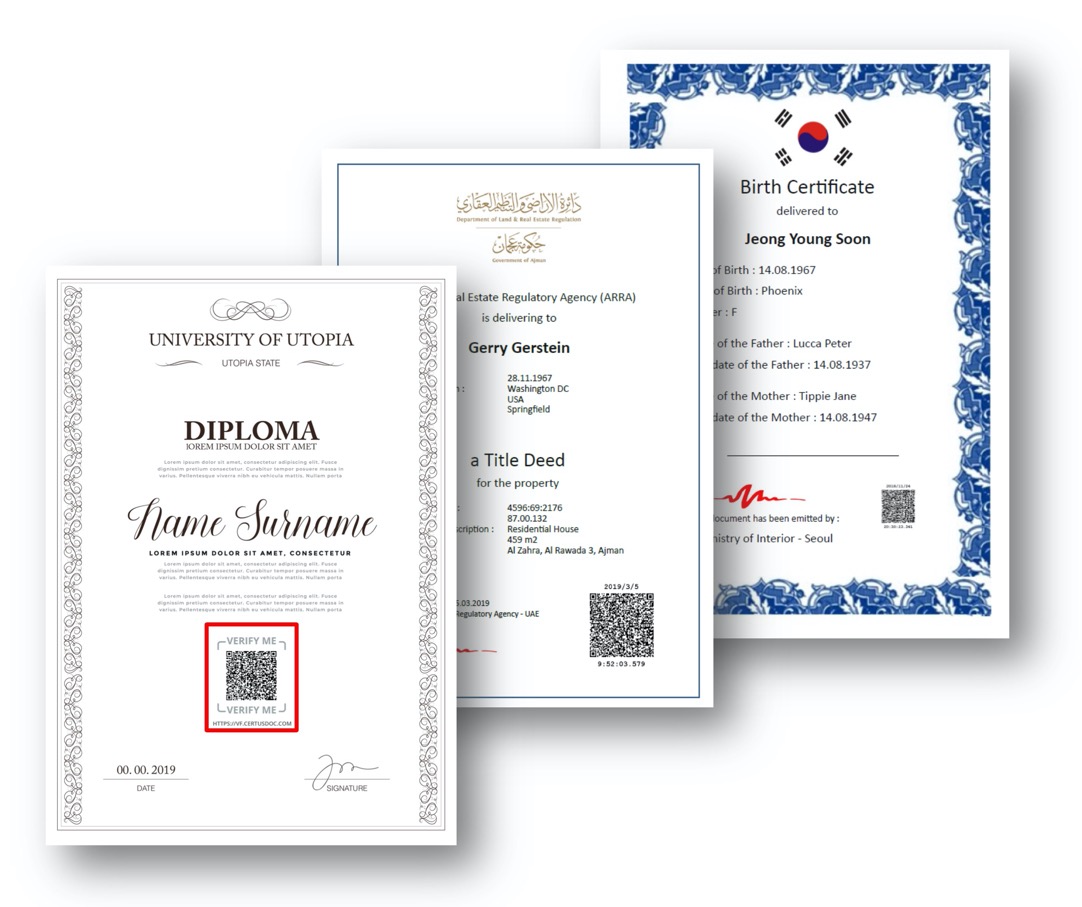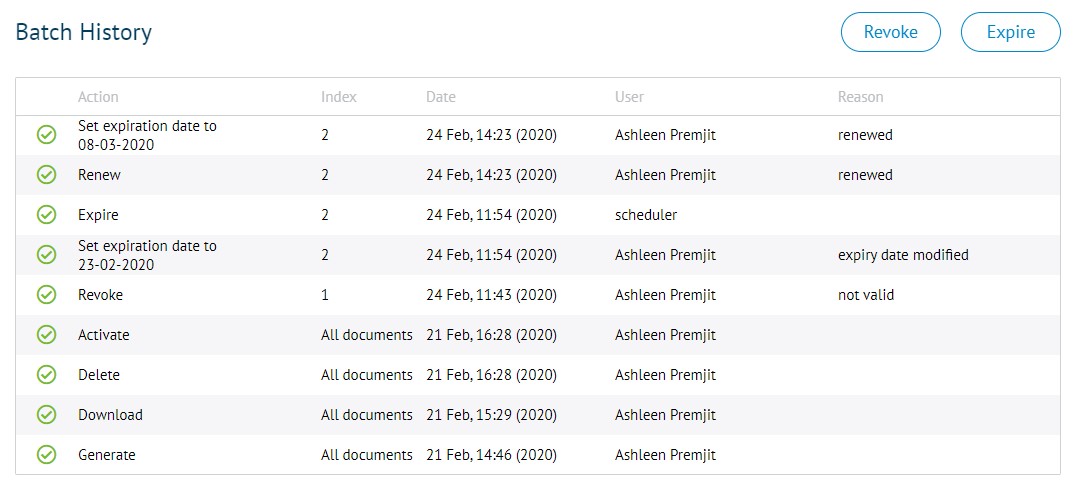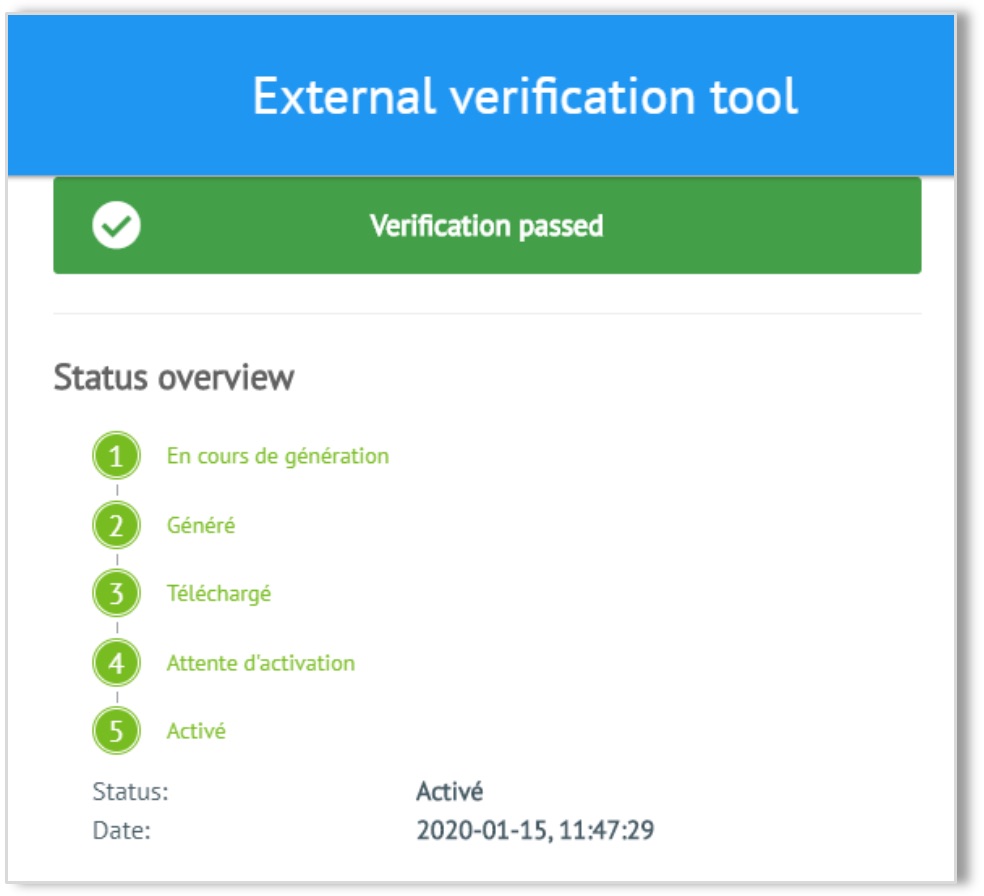FAQ
What is CERTUS?
CERTUS is an novel digital solution that allows document issuers like educational institutions, government bodies or notaries to secure sensitive paper-based and digital documents and credentials with a secure QR-code marking inserted on the document.

The tamper proof technology behind the solution enables document holders to secure lifelong proof of the validity and authenticity of their credentials. Any third-party verifiers like employers, government officials, auditors etc. have a very simple, reliable and cost-effective means to carry out independent verification without having to revert to the original issuing authority.
Why adopt CERTUS to secure certificates?
The CERTUS solution is primarily designed to help protect the reputation of issuers, safeguard trust among document holders and assure verifiers who all need a simple and low-cost means to authenticate claims. The main advantages of CERTUS are:
- Simple, reliable and cost-effective solution that is easy to implement ‐ No installation needed as CERTUS is a fully cloud-based service with seamless web/mobile app authentication.
- CERTUS secures both paper and digital documents without storing any sensitive data, which makes it a unique solution on the market.
- CERTUS provides third parties like employers, government officials, auditors etc. with a simple mean to carry out independent verification using an open and self-contained verification feature that functions independently from the issuer and does not require any special infrastructure.
- CERTUS enables document holders to have 100 percent and lifelong confidence in their ability to irrefutably authenticate/certify the content of the document issued to them and in the integrity of the issuing process.
Who is CERTUS for?
CERTUS is a versatile solution designed for use by a range of document-issuing authorities worldwide, such as educational institutions, government authorities and any other official bodies. The type of documents and records that can be protected by CERTUS includes:
- Academic Records: Degree and Diploma Certificates, Course Completion Certificate.
- Civic Records: Certificates of Birth, Death, Marriage.
- Legal Records: Notarial acts, Property Title deeds, Will, Apostille.
- Official documents: Vehicle registration, Licence to operate.
- Financial Records: Grant, Loan, Proof of insurance.
- Health Records: Prescription, Personal medical record, Licence to practice.
- Business Records: Trade licence, Tax certificate, Invoices.
Certificates, official documents and records carry lifelong importance and value for holders. CERTUS helps protect the reputation of issuers and offers peace of mind to document holders as well as a simple, reliable and cost-effective means for verifiers to carry out checks. CERTUS also helps issuers free up resources spent on traditional verification processes.
Why SICPA?
Founded in 1927 and based in Lausanne, Switzerland, SICPA is the world’s leading provider of secure identification, traceability and authentication solutions and services. Every day, governments, companies and millions of people rely on us to protect the integrity and value of their currency, personal identity, products, documents and brands. SICPA operates worldwide, with offices and factories on five continents, providing technologies and services to more than 180 countries. Making the world more secure for everyone is our business purpose.
Do issuers need to install on-premise infrastructure?
CERTUS is a software solution delivered as a service (SaaS). All functionalities of the solution are available through a web user interface secured by a https internet connection. There is no requirement for any additional software to be installed on desktops or for any additional on-premise infrastructure.
Can i integrate CERTUS into my existing processes and systems?
CERTUS’ open API allows seamless integration into your existing environment and enables Issuer to automatically manage the entire process of issuing and activating secured documents without leaving your user’s familiar environment.
What are the minimum technical requirements for CERTUS?
The CERTUS solution requires the following minimum operating requirements:
- Stable internet connection (> 5 Mbps);
- Latest version of the Edge OR Chrome web browser;
- Screen width of 1366px or more.
Can issuers revoke or expire documents?
The CERTUS document manager includes a life cycle management component. Each document (or batch of documents) can be revoked or expired at any time by the issuer, for example in the case of credentials that have a time-bound validity.

What does CERTUS secure?
CERTUS enables all parties (issuers, holders and verifiers) to have 100% confidence and trust in the integrity of certificate issuing process, and provides independent lifelong proof of:
- The date and time of issuance of the document;
- The name of the issuing authority;
- The current validity of the document (Active, Expired, Revoked);
- The authenticity of the underlying claim.
How can verifiers be sure they are using the right verifier?
The CERTUS universal verification technology is an open algorithm which means that anyone can use it to build a verification application.
SICPA operates a standard verifier that serves as a point of reference (www.CERTUSdoc.com). SICPA also certifies trusted verifiers from known partners and keeps an updated that can be found here: www.CERTUSdoc.com/verifier/#/trustedPartners.
Caution: Accurate certificate authentication can only be undertaken using a trusted verifier. Fraudulent operators are known to manipulate users into utilising imitation verifiers and deceptive verification processes. The best way to verify documents is either by using the verifier service operated directly by your trusted issuer or the official SICPA verifier (www.CERTUSdoc.com).
How can holders use CERTUS to get secure certificates?
To guarantee the integrity of the issuing process and the authenticity of a holders’ certificates, the issuer of this certificate should enrol in the CERTUS network of trusted partners. Talk to your issuer about the CERTUS solution and invite him to contact us. The more issuers start protecting their assets with this universal technology the stronger the trust network will grow.
Why use secure qr code as a medium?
Machine readable QR-codes allow seamless verification of both the paper and the digital version of any certificate using largely available mobile computing devices.
How is process integrity guaranteed?
CERTUS protects the integrity of the issuing process by generating irrefutable proofs at each step of the secured process. Prior to changing any state, the current environment is verified to make sure no irregular changes have affected the integrity of the data process. The state change is then triggered following the process definition and the new state and environment is secured by a new layer of proofs. The cumulation of all the proofs guarantees the integrity of the issuing process.

How does CERTUS protect privacy?
One of the strongest competitive advantages of CERTUS is that it secures both paper and digital documents without storing any sensitive data (the sensitive data remains only on the document and in the QR-code attached to it). After generation, the sensitive data of the document is deleted from the CERTUS servers and is not required for the verification of the documents.
CERTUS stores only the digital seals (which do not contain any sensitive data) and some meta data like the date of issuance. The issuer keeps full control of the document holder’s personal information.
